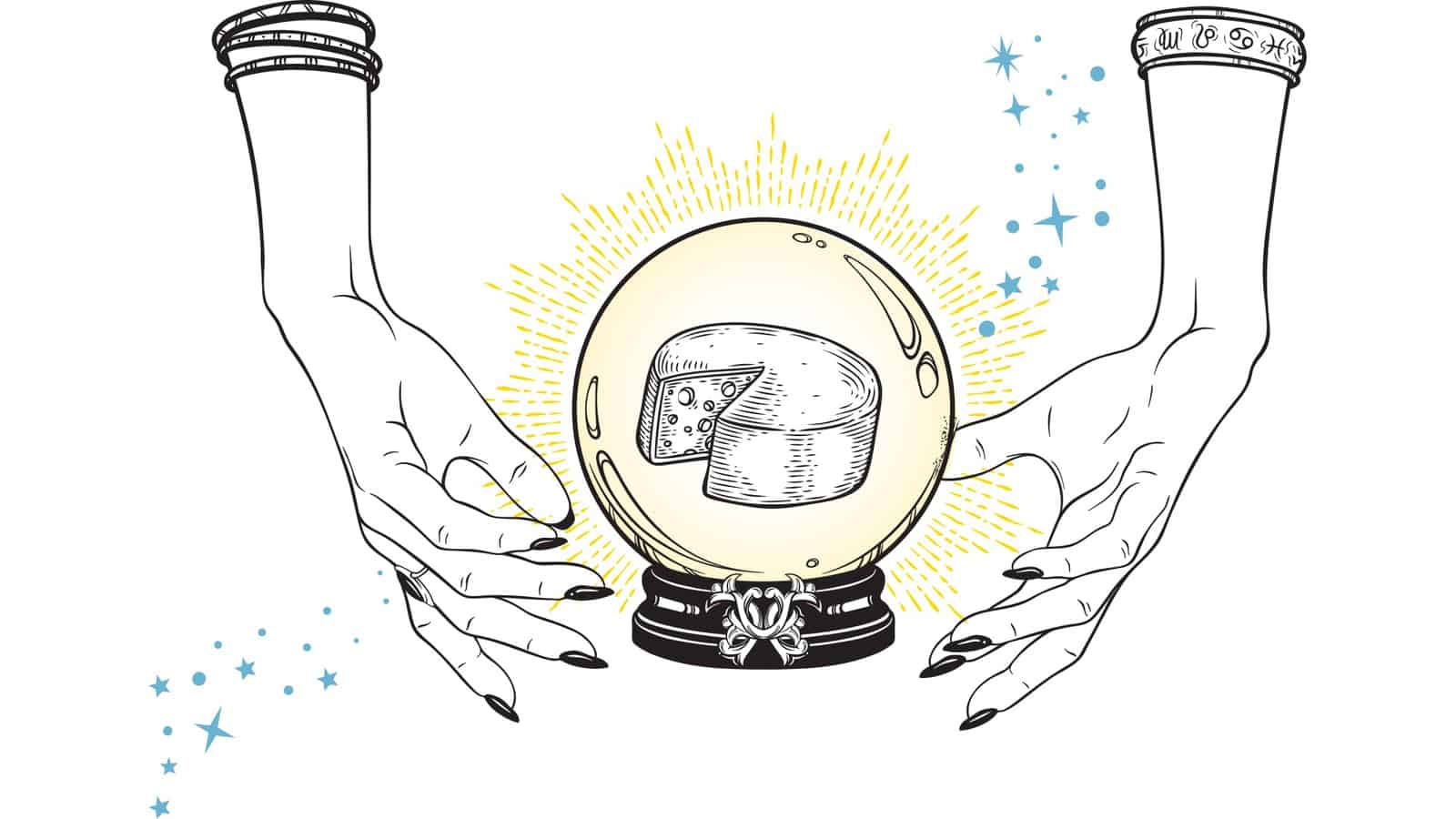
Thousands of years ago, someone figured out that milk could be curdled—that its solids could be isolated and captured into something distinct and delicious. Just like that. Like magic.
Food and magic have long been intertwined. The notion of a “kitchen witch” is pervasive: Historically, cooking was a female undertaking, the hearth a place of spiritual authority. Wisdom passed from mother to daughter included recipes and rituals, ceremonial dishes, and curious curds—and as we kitchen witches know, cheese is particularly potent when it comes to magic.
Cheese is sensual: a feeling on the tongue, a snap against the teeth; creamy colors with marbled or golden overtones; shades of flavor and smells of earth. Existing on the threshold of life and decay, it represents transformation: a life-giving substance undergoing controlled deterioration and deepening complexity. Aged wheels reflect the milk from which they came but have become something greater. It’s little wonder that cheese has been used to influence good fortune, heal the sick, and predict the future—a spooky history that informs its symbolism at today’s table.
Myth and Legend
The ancient Greeks attributed cheesemaking skills to divine intervention; Aristaeus, the god of shepherds and beekeepers, learned to curdle milk from nymphs before sharing his knowledge with humans. It was thus typical for the Greeks and Romans to include cheese in offerings to deities: For example, a soft white cheese mixed with pounded garlic was presented to the Great Mother at the feast of Cybele, and a series of three cheesecakes were offered to the goddess of childbirth during Roman summer festivals.
In the British Isles, legends tell of fairies, or “wee folk,” who have a penchant for cheese. Satisfying their appetite ensures a bountiful harvest and good health. Along an ancient trail in Peeblesshire, Scotland, two rocks mark a spot called the Cheese Well. According to superstition, those who pass by should throw a nibble of cheese into it as an offering to the fairies, to whom it belongs.
Because it can be carved with symbols and eaten with intention, cheese has also been used to carry both Pagan and adapted Christian spells, summoning good fortune, providing protection, or healing illness. In Icelandic folklore, for instance, a suitor would carve cheese with symbols before giving it to a young woman, hoping she’d fall in love with him after eating it.

A wedge of Epoisse. Photo Credit The Cheese Shop of Salem
Fromage Fortune
Fortunetellers can choose from a range of tools and techniques, from rune stones to tarot cards. Some see signs of the future in natural objects: a sudden flash of lightning, the spontaneous laugh of a child, the appearance of an animal. In ancient times, life-giving, rich foods were also used as divination tools: eggs, animal intestines, and, yes, cheese.
As it turns out, reading cheese—called tyromancy—was used in the Middle Ages to divine the past, present, and future. Like the reading of tea leaves, it was a way to connect revealing patterns and symbols. Working with cheese in all its endless variety supplied the medium with different types of energy. Holes made from gas, like those found in Swiss cheese, could draw upon numerology, whereas the veins in blue cheese often formed images. Bumps, cracks, and mottled rinds revealed shapes that the cheese reader could interpret into predictions of love, money, travel, and sacrifice.

Goat cheese with lavender
Modern Magic
As a present-day kitchen witch, I know that two of the most important ingredients are intention and energy. Making a magical meal with cheese can be as simple as whispering a blessing into the dish while preparing it, or pairing curds, herbs, and spices to accomplish goals: rosemary for protection, basil for love, lavender for purification, and charcoal to repel malevolent magic.
Spell-making is based on symbolic parallels, and cheeses yield no shortage of them: The smooth curves of a mozzarella fit in a spell for a healthy childbirth; a gentle chèvre might comfort a child wrestling with nightmares. You can turn to intense cheeses to invite adventure into your life, or to rusty, aged wheels when searching for knowledge or a mentor.
It’s all about seeing cheese as a reflection of experience. “Our lives are our greatest magic,” writes author and Wiccan priestess Phyllis Curott in her book Witch Crafting (Harmony, 2001). Kitchen witchery invites us to be mindful about how we prepare and share food. Cheese divination acts as an inkblot, triggering unconscious feelings, and personal conversations are often cultivated in the company of loved ones…with a glass of robust wine and an overflowing plate of cheese.
DIY Cheese Witchery
Take cheesy spell-making into your own kitchen with these tips derived from ancient texts and folklore. For more info, snag a copy of Claude Lecouteux’s Dictionary of Ancient Magic Words and Spells (Inner Traditions, 2015) or Henry Carrington Bolton’s The Counting-Out Rhymes of Children (Forgotten Books, 1888).
►To compel someone into action, carve a phrase of intention onto a cheese and place it at their doorstep.
►Have a burning question? Carve the possible one-word answers onto a fresh wheel of cheese, then leave it in a sacred space until mold begins to form on the rind. The first word to fill with mold is the correct answer.
►If you want to know who will succeed in a given task, present an animal with an assortment of cheeses, each carved with a person’s name; the animal will eat the winner first.
►If you expect someone is a thief, write the words AGULA, IGULA, and AGULET on a piece of cheese, and give it to the accused; a guilty suspect will not be able to swallow it.
►To rid your cow of bewitchment, take a wheel of its cheese and draw a cross over the top. Then write INIPSO on its first quarter, CUMIPSO on its second quarter, PERIPSUM on its third, and in a circle surrounding the cross, write SUMOMNIA.



